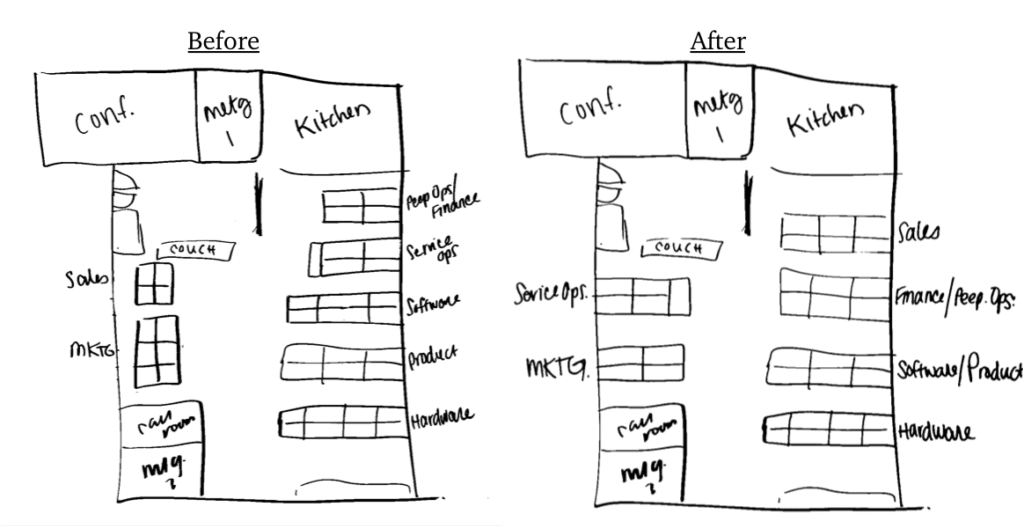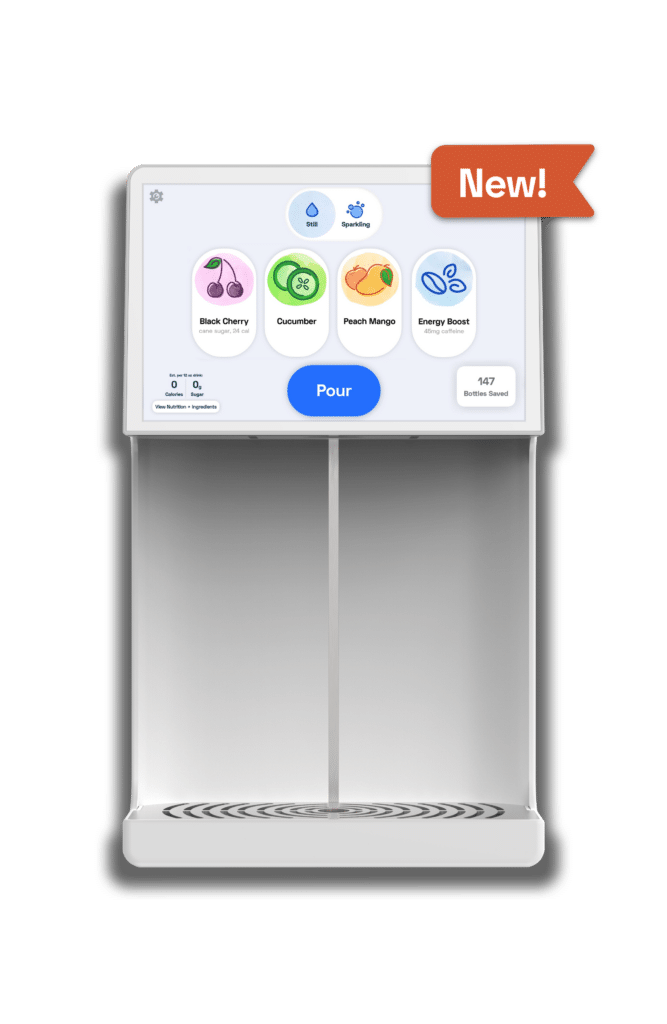Not all company growth requires a brand new office; often times, a few adjustments to the current office layout can make a big impact, ultimately helping your space become both more productive as well as accommodating of future growth.
For quickly growing startups like Bevi, each round of hiring presents a challenge to the delicate balance of the current floor plan. Teams begin to outgrow their original areas, and suddenly 7 people are sitting in a space that was designed for 2. And since many startups have an accelerated hiring timeline, this puts a lot of pressure on Office Managers, HR, or Facilities Managers to change the office layout quickly and seamlessly. No matter what the occasion, rearranging an office space can be stressful — especially when current employees are not 100% on board.
We’ve got your back. We interviewed our own all-star Office Manager, Claire, to put together this list of 11 things to do before, during, and after a change to the office layout. We can’t promise that the office won’t mutiny, but at least you’ll have a contingency plan if they do (see #3 for some of Claire’s tips).
1. Get key stakeholders on board

Regardless of your company’s size, getting key stakeholders on board is the first step towards getting the entire office to buy into the changes. Key stakeholders are more likely to recognize how space adjustments will benefit the company as a whole and can communicate this directly with their respective teams. Especially if you work for a larger company and don’t know everyone by name, employees are more likely to cooperate with someone they know and trust.
2. Use the layout change as an excuse to check in and ask what each team needs
Another strategy for getting each team excited about the change-up is to actively incorporate their goals and needs into the new office schematic. Whether informally in the hallway or at an all-hands meeting, check in with each team to see what they like about their current format and what they would change. By proactively discussing their needs and concerns, you are helping deflect any dissent in the long term.
3. Establish a trial period and streamlined feedback system
No matter how much you plan, there will always be something to work out after the rearranging is done. For this reason, it’s good to establish a trial period, so that in one or two weeks time you can reassess whether the new layout is working out.

Source: Pixabay
During the trial period, have your employees send feedback to a designated Slack channel or survey. This way, folks have a space to express their concerns and you have the ability to mute their reactions until the trial period comes to a close.
If you’re really getting bombarded with comments or requests, ask your own manager to openly address (and shut down) any opposition. It’s always nice to have someone on your side to help deflect any whining — it really gets old after awhile.
4. Keep open positions in the hiring pipeline in mind

Source: Pixabay
If you have the opportunity to make a change, think big! Chances are there are several open positions at your company, so think about how your desks will be populated once new employees arrive. Consider syncing-up with HR or senior management to find out the teams the company is looking to expand over the next quarter (or year) so you minimize the amount of times you’ll have to reorganize the office.
5. Put yourselves in a visitor’s shoes

Source: Unsplash
Whether they’re investors or user testing groups, visitors expect to see people hard at work upon entering your office. Put your company’s best foot forward by making sure the teams closest to your front door (or visitor entrance, if you have a larger company) are typically in the office.
Here at Bevi HQ, we have a stellar hardware team that spends a good portion of their time in our engineering lab a few floors down. Our Office Manager Claire had the foresight to situate the hardware team in the back corner of our office, so our visitors would never be greeted by empty desks.
6. Constant communication before, during, and after
Similar to #2 and #3, constant communication is key. Between Slack messages and email updates, be sure to remind your employees to pack up their belongs 1 week and 1 day before the move as well as on the day of.
Once the layout has been changed, it’s a good idea to send an early morning reminder with the new seating chart and instructions on how to inquire about any missing belongings. Our Office Manager Claire made sure everyone stayed in the loop by giving email and in-person reminders in the days leading up to the reshuffling.
7. Sketches, diagrams, and maps, oh my!
X marks the spot. Before moving anything in your office, sketch out a few options for a new office set-up. Pro-tip: always make sure they are to scale!

Office Manager Claire breaks down Bevi HQ’s most recent layout change.
If you consider yourself visually or spatially inept, ask a designer or engineer to help you realize your vision. They might even have some handy software that can help make testing different layouts much more efficient than using a ruler and graphing paper. For example, Eliza, one of Bevi’s co-founders, helped Claire model different versions of the office without moving a single desk.
8. Strategically pick a time when the office will be nearly empty
While you will need an extra set of hands to make the rearrangement happen, less is more when it comes to having people in the office during all of the shuffling.
Aside from staying late on an arbitrary weekday, the day before a long weekend or holiday is often the perfect time to make your move. Back in November, our superstar Office Manager Claire planned to change things around in the office on the day before Thanksgiving. It worked out well as there were a few folks in the office to lend a hand and enough room to reposition the furniture without disturbing anyone. Within a few hours, everything was readjusted and ready for the new hires starting the following Tuesday — myself included!
Plus, let’s be honest: when the majority of people are out of the office, those who do come into work often look for fun side projects to work on. These people are your biggest asset on the day of the move.
9. Set aside time for furniture assembly

Source: StockSnap.io
A new layout often means new furniture. But don’t be fooled: you’re going to need a screwdriver and hammer before your furniture looks as shiny and perfect as it did on Ikea’s website.
10. Four hands are better than two

Source: Burst
Even the office hero needs a little help once in a while. Rather than trying to rough it by yourself, enlist a few helpers to move or assemble desks and chairs while you double check the diagram of the new set-up. For medium-sized or large companies, you’re better off hiring movers to help you get the job done quickly and efficiently.
11. Label like your life depends on it
With just over 30 people working in Bevi HQ, the office is certainly on the smaller side. Nevertheless, a few things did get lost in our most recent round of office rearrangements. Take it from us: labeling is everything.

Source: StockSnap.io
Whether with masking tape, printed labels, sharpies, or cute cat stickers, make sure everyone clearly labels the box containing their belongings before anything gets touched. You’ll thank yourself later.
Looking for more ways to keep your office happy and healthy? Meet Bevi, the smart water cooler designed to make your life as office manager that much easier.
Request a free flavor tasting for your office here.






